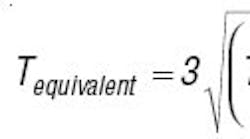General sizing procedures
Precision planetary servo gears are ideal for applications with dynamic loads, changing speeds, and frequent starts and stops. The first step in selecting the proper gear size is to analyze an application's motion profile and duty cycle. Usually, applications have strongly fluctuating, dynamic loads. Therefore, engineers need to determine an "equivalent load." The formula most often used is:
Without going into a detailed explanation, RMS values are applicable for motor selection; expressing thermal and current limitations. In the case of a planetary servo gearbox, the governing factor is mechanical fatigue limitations. The factor 1/3 certainly reminds one of the L10 Bearing life calculation.
Gearbox rated torque at continuous load must be equal to or higher than calculated equivalentload torque. This datum and the selected servomotor and reduction ratio will determine the appropriate servo gearbox size and type. It's worth checking the maximum applicable torque, sometimes referred to as emergency stop or allowable momentary peak torque. It indicates the maximum number of cycles a gearbox can withstand before catastrophic failure.
How it works
A typical planetary servo gearbox connects directly to a servo motor through a backlash free clamp. Matching the square shape of the motor, the assembly results in a compact system often called a servo gearmotor.
Because of the way planetary gear systems handle load, they are uniquely suited to applications involving high dynamic loads, requiring high stiffness, high torque density, low inertia, high efficiency and high input speeds. Standard gear systems transfer the whole load through one gear mesh. A planetary system, however, usually has a minimum of three gear meshes, depending on the number of planet gears.
This inherently balanced system also automatically redistributes any lubricant, allowing input speeds in excess of 6,000 rpm.
Common applications
Planetary servo gearboxes cover the entire range of automation. They are often found in pick-and-place systems, loading and unloading gantry robots, in packaging machinery and in positioning tables in medical equipment, and driving rotary and linear actuators.
Despite the increasing torque density of ac servo motors, a suitable servo gearbox is still usually required to match the inertias, boost motor torque and reduce motor speed.
Planetary servo gears are usually manufactured with tight tolerances and low backlash. Because their high torsional stiffness minimizes lost motion, they can offer precise positioning.
Installation and maintenance
The latest planetary servo gears are designed for exceptionally long, maintenance-free life. For instance, a standard gearbox usually has 5,000 hours L10 bearing life. Some planetary servos offer 20,000 hours L10 life.
Synthetic grease is constantly being distributed, making relubrication unnecessary. Use of grease also lets the gearbox be mounted in any position.
Assuming a proper sizing and mounting, a quality planetary servo gearbox is virtually maintenance free. Be sure to follow manufacturers' mounting procedures and recommended clamping torques carefully to avoid slippage of the motor shaft in the bore of the sun gear. Slippage will damage the shaft and gear.
Check seal leakage and heat periodically. Seals rub on the shaft and eventually wear out. However, an appropriate design, tight tolerances, use of quality materials, high surface finish, and pressure relief systems can extend seal life for years of trouble free operation.




